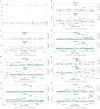Genetic Analysis Reveals a Protective Effect of Sphingomyelin on Cholelithiasis
- PMID: 40428345
- PMCID: PMC12110971
- DOI: 10.3390/genes16050523
Genetic Analysis Reveals a Protective Effect of Sphingomyelin on Cholelithiasis
Abstract
Background: Cholelithiasis is the most common disorder affecting the biliary system. Choline is an essential nutrient in the human diet and is crucial for the synthesis of neurotransmitters. Previous studies have suggested an association between choline metabolites and cholelithiasis. However, the underlying mechanisms remain unclear. This research aims to fill the knowledge gap regarding the role of choline metabolites in cholelithiasis.
Methods: Genetic data related to choline metabolites and other covariates were retrieved from the U.K. Biobank and IEU OpenGWAS database. Two-sample (TSMR) and multivariate Mendelian randomization (MVMR) analyses, mediation analysis, linkage disequilibrium score regression (LDSC), colocalization analysis, and enrichment analysis were performed.
Results: A significant causal relationship was identified between serum level of sphingomyelin and cholelithiasis (p-value = 0.0002). A protective causal effect was identified in MVMR analysis. The following mediated MR analysis indicated that only LDL mediated a large part of the causal relationship (59.18%). Seven genes, including GCKR, SNX17, ABCG8, MARCH8, FUT2, APOH, and HNF1A, were revealed to be colocalized with the causal signal between sphingomyelin and cholelithiasis.
Conclusion: The present study has identified a protective effect between sphingomyelin and cholelithiasis. This effect is largely mediated by LDL. The findings of this study offer valuable information for further exploration of the molecular mechanisms of cholelithiasis.
Keywords: Mendelian randomization; cholelithiasis; choline metabolites; colocalization analysis; low-density lipoprotein.
Conflict of interest statement
All authors declare that the research was conducted in the absence of any commercial or financial relationships that could be construed as a potential conflict of interest. The funders had no role in the design of the study; in the collection, analyses, or interpretation of data; in the writing of the manuscript; or in the decision to publish the results.
Figures




Similar articles
-
The Causal Relationship Between Choline Metabolites and Acute Acalculous Cholecystitis: Identifying ABCG8 as Colocalized Gene.Nutrients. 2024 Oct 22;16(21):3588. doi: 10.3390/nu16213588. Nutrients. 2024. PMID: 39519421 Free PMC article.
-
Identification of blood metabolites linked to the risk of cholelithiasis: a comprehensive Mendelian randomization study.Hepatol Int. 2022 Dec;16(6):1484-1493. doi: 10.1007/s12072-022-10360-5. Epub 2022 Jun 15. Hepatol Int. 2022. PMID: 35704268
-
Whole Transcriptome-wide Analysis Combined With Summary Data-Based Mendelian Randomization Identifies High-Risk Genes for Cholelithiasis Incidence.Clin Transl Gastroenterol. 2025 May 1;16(5):e00800. doi: 10.14309/ctg.0000000000000800. Clin Transl Gastroenterol. 2025. PMID: 39840844 Free PMC article.
-
Exploring new drug treatment targets for immune related bone diseases using a multi omics joint analysis strategy.Sci Rep. 2025 Mar 27;15(1):10618. doi: 10.1038/s41598-025-94053-7. Sci Rep. 2025. PMID: 40148470 Free PMC article.
-
Exploring the genetic associations and causal relationships between antibody responses, immune cells, and various types of breast cancer.Sci Rep. 2024 Nov 19;14(1):28579. doi: 10.1038/s41598-024-79521-w. Sci Rep. 2024. PMID: 39562684 Free PMC article.
References
MeSH terms
Substances
Grants and funding
LinkOut - more resources
Full Text Sources
Medical
Miscellaneous

